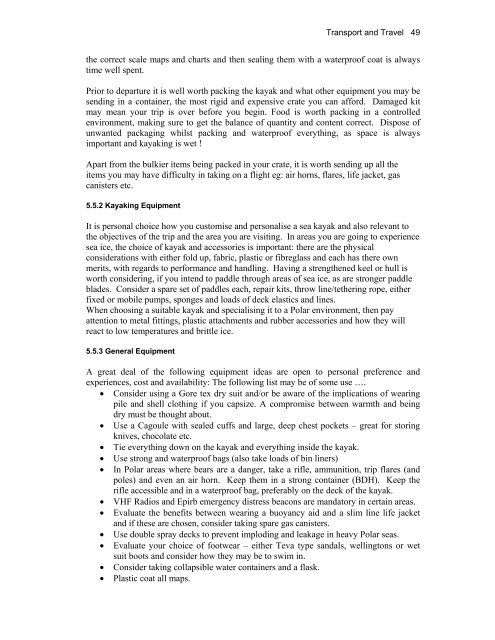Edited by Rachel Duncan 4th Edition ISBN 0-907649-91-2 London ...
Edited by Rachel Duncan 4th Edition ISBN 0-907649-91-2 London ...
Edited by Rachel Duncan 4th Edition ISBN 0-907649-91-2 London ...
You also want an ePaper? Increase the reach of your titles
YUMPU automatically turns print PDFs into web optimized ePapers that Google loves.
Transport and Travel 49<br />
the correct scale maps and charts and then sealing them with a waterproof coat is always<br />
time well spent.<br />
Prior to departure it is well worth packing the kayak and what other equipment you may be<br />
sending in a container, the most rigid and expensive crate you can afford. Damaged kit<br />
may mean your trip is over before you begin. Food is worth packing in a controlled<br />
environment, making sure to get the balance of quantity and content correct. Dispose of<br />
unwanted packaging whilst packing and waterproof everything, as space is always<br />
important and kayaking is wet !<br />
Apart from the bulkier items being packed in your crate, it is worth sending up all the<br />
items you may have difficulty in taking on a flight eg: air horns, flares, life jacket, gas<br />
canisters etc.<br />
5.5.2 Kayaking Equipment<br />
It is personal choice how you customise and personalise a sea kayak and also relevant to<br />
the objectives of the trip and the area you are visiting. In areas you are going to experience<br />
sea ice, the choice of kayak and accessories is important: there are the physical<br />
considerations with either fold up, fabric, plastic or fibreglass and each has there own<br />
merits, with regards to performance and handling. Having a strengthened keel or hull is<br />
worth considering, if you intend to paddle through areas of sea ice, as are stronger paddle<br />
blades. Consider a spare set of paddles each, repair kits, throw line/tethering rope, either<br />
fixed or mobile pumps, sponges and loads of deck elastics and lines.<br />
When choosing a suitable kayak and specialising it to a Polar environment, then pay<br />
attention to metal fittings, plastic attachments and rubber accessories and how they will<br />
react to low temperatures and brittle ice.<br />
5.5.3 General Equipment<br />
A great deal of the following equipment ideas are open to personal preference and<br />
experiences, cost and availability: The following list may be of some use ….<br />
• Consider using a Gore tex dry suit and/or be aware of the implications of wearing<br />
pile and shell clothing if you capsize. A compromise between warmth and being<br />
dry must be thought about.<br />
• Use a Cagoule with sealed cuffs and large, deep chest pockets – great for storing<br />
knives, chocolate etc.<br />
• Tie everything down on the kayak and everything inside the kayak.<br />
• Use strong and waterproof bags (also take loads of bin liners)<br />
• In Polar areas where bears are a danger, take a rifle, ammunition, trip flares (and<br />
poles) and even an air horn. Keep them in a strong container (BDH). Keep the<br />
rifle accessible and in a waterproof bag, preferably on the deck of the kayak.<br />
• VHF Radios and Epirb emergency distress beacons are mandatory in certain areas.<br />
• Evaluate the benefits between wearing a buoyancy aid and a slim line life jacket<br />
and if these are chosen, consider taking spare gas canisters.<br />
• Use double spray decks to prevent imploding and leakage in heavy Polar seas.<br />
• Evaluate your choice of footwear – either Teva type sandals, wellingtons or wet<br />
suit boots and consider how they may be to swim in.<br />
• Consider taking collapsible water containers and a flask.<br />
• Plastic coat all maps.

















